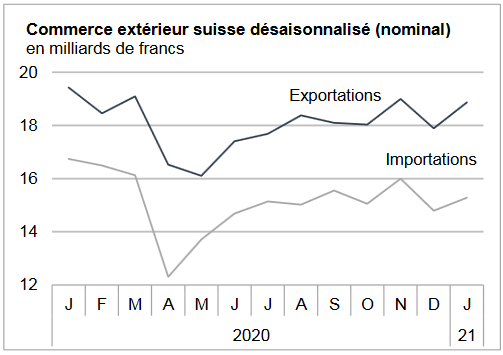We do not like Purchasing Power or Real Effective Exchange Rate (REER) as measurement for currencies. For us, the trade balance decides if a currency is overvalued. Only the trade balance can express productivity gains, while the REER assumes constant productivity in comparison to trade partners. Who has read Michael Pettis, knows that a rising trade surplus may also be caused by a higher savings rate while the trade partners decided to spend more. This is partially true. Recently Europeans started to increase their savings rate, while Americans reduced it. This has led to a rising trade and current surplus for the Europeans. But also to a massive Swiss trade surplus with the United States, that lifted Switzerland on the U.S. currency manipulation watch list. To
Topics:
George Dorgan considers the following as important: 2) Swiss and European Macro, 2.) Trade Balance News Service Bunt [FR], Featured, newsletter
This could be interesting, too:
Eamonn Sheridan writes CHF traders note – Two Swiss National Bank speakers due Thursday, November 21
Charles Hugh Smith writes How Do We Fix the Collapse of Quality?
Marc Chandler writes Sterling and Gilts Pressed Lower by Firmer CPI
Michael Lebowitz writes Trump Tariffs Are Inflationary Claim The Experts
We do not like Purchasing Power or Real Effective Exchange Rate (REER) as measurement for currencies. For us, the trade balance decides if a currency is overvalued. Only the trade balance can express productivity gains, while the REER assumes constant productivity in comparison to trade partners.
Who has read Michael Pettis, knows that a rising trade surplus may also be caused by a higher savings rate while the trade partners decided to spend more. This is partially true. Recently Europeans started to increase their savings rate, while Americans reduced it. This has led to a rising trade and current surplus for the Europeans. But also to a massive Swiss trade surplus with the United States, that lifted Switzerland on the U.S. currency manipulation watch list.
To control the trade balance against this “savings effect”, economists may look at imports. When imports are rising at the same pace as GDP or consumption, then there is no such “savings effect”.
After the record trade surpluses, the Swiss economy may have turned around: consumption and imports are finally rising more than in 2015 and early 2016. In March the trade surplus got bigger again, still shy of the records in 2016.
Swiss National Bank wants to keep non-profitable sectors alive
Swiss exports are moving more and more toward higher value sectors: away from watches, jewelry and manufacturing towards chemicals and pharmaceuticals. With currency interventions, the SNB is trying to keep sectors alive, that would not survive without interventions.
At the same time, importers keep the currency gains of imported goods and return little to the consumer. This tendency is accentuated by the SNB, that makes the franc weaker.
Texts and Charts from the Swiss customs data release (translated from French).
| Swiss foreign trade showed dynamism in the second quarter of 2021. Exports rose 3.2% to a record level. They posted a fourth consecutive quarterly increase since the drop recorded at the start of the coronavirus pandemic. Imports continued the momentum of the previous quarter and increased 3.8%. The trade surplus stood at 11.5 billion francs.
In short ▲Bullish trend for chemicals and pharmaceuticals trade ▲Fourth straight increase in metal imports ▲Spain: record quarterly level in both traffic directions |
Swiss exports and imports, seasonally adjusted (in bn CHF), Q2 2021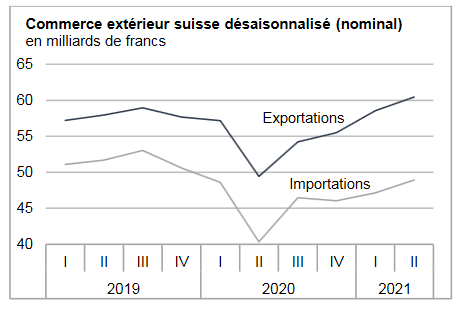 Source: newsd.admin.ch - Click to enlarge |
Global evolutionOn a seasonally adjusted basis, the positive trend continued for exports in the second quarter of 2021, with + 3.2% or +1.9 billion francs (actual: + 1%). They thus recorded their fourth increase in a row and crossed the 60 billion francs mark for the first time in a quarter. Imports gained 3.8% or 1.8 billion francs (actual: + 1.2%). After a mixed second half of 2020, they are once again above their level for the first quarter of 2020. The trade balance has closed with a record surplus of 11.5 billion francs. |
Switzerland Trade Balance, June 2021(see more posts on Switzerland Trade Balance, )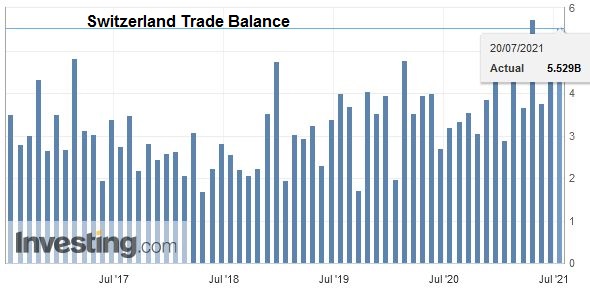 Source: investing.com - Click to enlarge |
Exports: immunological products set the toneIn the second quarter of 2021, three quarters of the growth in exports rested on chemicals and pharmaceuticals (+1.4 billion francs). In this group, immunological products (+527 million) as well as raw and basic materials (+453 million or + 22.7%) performed well. Sales of metals (+ 5.7%) and watchmaking (+ 1.9%) also continued their momentum, even if their pace slowed compared to previous quarters. The latter even returned to its impressive level of 2019. Precision instruments also increased while the machinery and electronics sector declined. Jewellery (-5.1%), meanwhile, posted a second consecutive quarterly decline. Of all the main Swiss markets, only Europe posted an increase (+1.8 billion francs or + 5.6%). Here, exports to Spain (immunological) surged, shattering their previous quarter record of 641 million francs or 27.5%. Germany (+387 million), Austria and Belgium were not to be outdone. After its 1st quarter setback, the United Kingdom turned the tables (+245 million; + 13.9%). Conversely, sales with Asia and North America suffered (-1.7 and -0.6% respectively). For the first, China (-602 million or -14%) pulled the continental result in the red while Japan and Singapore (record) together increased by 322 million francs. On the North American continent, the USA weakened by 1.1% after their performance in the previous quarter. |
Swiss Exports per Sector Q2 2021 vs. 2020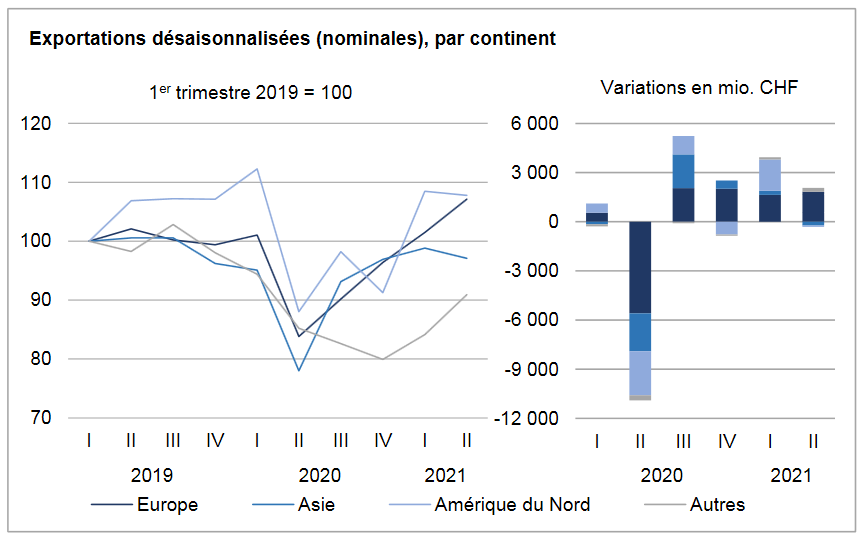 Source: newsd.admin.ch - Click to enlarge |
Imports: growth for the three main continentsOn imports, two out of three commodity groups gained ground in the second quarter of 2021. As with the exit, chemicals and pharmaceuticals (+652 million francs or + 5.1%) contributed mainly to growth. Among them, immunological products as well as raw and basic materials rose by a tenth and a sixth respectively. The entries of active ingredients, on the other hand, fell by half. Energy products (+ 28.8%) and metals (+ 8.8%) also massively supported the rise in imports (cumulative: +750 million). The latter even returned to their 2019 level, thanks to a fourth successive increase. Conversely, vehicles (-1.6%) remain in a negative spiral in 2021. Imports have intensified from all major continents. While Europe has made the most progress in absolute terms (+986 million francs; + 2.9%), it is still two billion francs below its level of two years ago. With a one-fifth increase, Spain posted a record result, just like at the exit. In addition, France, Austria and the United Kingdom increased their deliveries to Switzerland by half a billion francs. Conversely, Ireland plunged by a third. Entries from North America (+ 15.2%; USA: + 14.3%) and Asia (+ 4.6%) also swelled. Within the latter, the doubling of imports from South Korea (immunological products) contrasted with the drop in those from Singapore (-30.4%). |
Swiss Imports per Sector Q2 2021 vs. 2020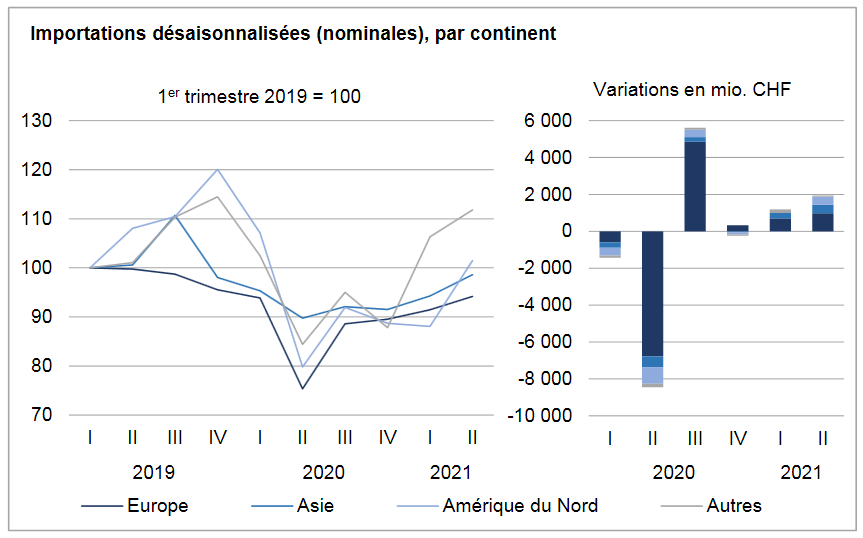 Source: newsd.admin.ch - Click to enlarge |
Tags: Featured,newsletter








